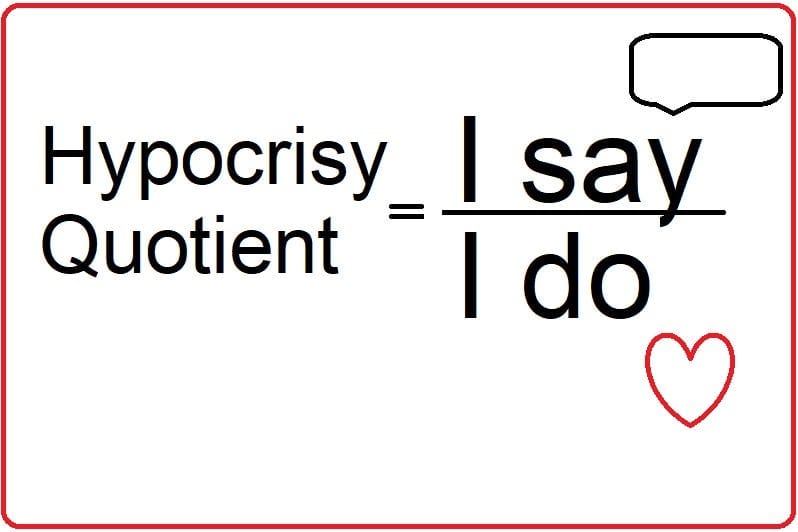Writing Satire
Look under the surface for the hypocrisy quotient

Satire conveys a real issue of hypocrisy. Script writers created weekly dilemmas for 11 years for “The Carol Burnett Show” that aired on CBS from 1967–78. There is an art to their substance. Like “All in the Family” with Archie Bunker, people not only laughed at them but identified with them. The “Hypocrisy Quotient” is what I say, divided by what I do. What number do you see? Few find 100% integrity. How great is your gap?
After hearing about not judging, and forgiveness in their Sunday church service, they do the opposite. The reality of hearing and not doing is the hypocritical reality. Laugh and “cut to the gut” at the same time.
What are the characteristics of satirical script writing? How do people call attention to inconsistences in behavior in a comical way? They tend to point out the incongruous behavior of individuals who say one thing and do another.
Making fun of hypocrites
Situational comedy is an entertainment style that catches our attention in ways that direct instruction does not. Satirical script writing takes actual events and looks under the surface to expose the reality of relationships. In this case, an adult mother and daughter reveal their inner critic, avoid their own accountability, and blame others for their own blindness.
In this video, now free on YouTube, the lack of brotherly love is exposed. “The Family: Brotherly Love” begins with a daughter and her husband entering her mother’s home after a church service. They are praising the preacher who spoke on Matthew 7.
“Do not judge, or you too will be judged. For in the same way you judge others, you will be judged, and with the measure you use, it will be measured to you. Why do you look at the speck of sawdust in your brother’s eye and pay no attention to the plank in your own eye? How can you say to your brother, ‘Let me take the speck out of your eye,’ when all the time there is a plank in your own eye? You hypocrite, first take the plank out of your own eye, and then you will see clearly to remove the speck from your brother’s eye.”
They exhibit just the opposite within a few minutes.
Brotherly love is a term that refers to a deep and affectionate love, care, and bond shared between individuals who are like brothers or close friends. It embodies the qualities of friendship, mutual support, and affection typically associated with the relationship between siblings. Brotherly love often involves a strong sense of camaraderie, loyalty, and a willingness to help and protect one another, much like the love and support that anybody might expect between brothers. It can extend to relationships outside of family, emphasizing the idea of treating others with warmth and compassion, as if they were close and beloved family members. This concept is often used to promote a sense of unity, goodwill, and community among people.
Satire defined
Writing satire is a form of literary or rhetorical art that uses humor, irony, and exaggeration to criticize or mock various aspects of society, human behavior, or institutions. Satire often aims to point out the absurdities, flaws, or contradictions in these subjects while entertaining and making the audience think. Here’s a step-by-step guide on how to write satire:
- Choose a Target: Identify the subject or target of your satire. This could be a social issue, a public figure, a cultural trend, a specific event, or any aspect of society that you want to critique.
- Understand Your Target: To effectively satirize something, you need a deep understanding of it. Research your target thoroughly, so you can pinpoint its weaknesses and inconsistencies.
- Select Your Satirical Approach:
- Exaggeration: Emphasize the flaws or absurdity of your target by exaggerating them. Make the situation or characteristics more extreme than they are in reality.
- Irony: Use irony to create a contrast between what is expected and what actually occurs. This can be verbal irony (saying one thing but meaning another) or situational irony (events unfolding in an unexpected way).
- Sarcasm: Employ sharp, witty, and often ironic remarks to mock or convey disapproval. Be careful not to overdo it, as sarcasm can become hurtful if taken too far.
4. Choose Your Satirical Tone:
- Light-Hearted: Maintain a humorous and playful tone, where the criticism is presented with a sense of amusement rather than anger.
- Dark or Juvenalian: Go for a more biting and critical tone, where you openly condemn the subject of your satire. This style is more severe and may come across as harsh.
5. Create Characters and Situations: Often, satire includes fictional characters or scenarios that represent real-life situations or people. These characters serve as vehicles for your commentary.
6. Use Wit and Wordplay: Employ clever wordplay, puns, and metaphors to make your points in a witty and entertaining manner. Play with language to create humorous or absurd effects.
7. Employ Satirical Devices:
- Hyperbole: Exaggerate things to the extreme to highlight their absurdity.
- Parody: Imitate or mimic a particular style, work, or individual to mock it.
- Incongruity: Create unexpected and illogical connections or situations to make your point.
8. Be Mindful of the Message: While humor is the primary vehicle in satire, make sure your message is clear. Your satire should convey a critical perspective or commentary on the subject.
9. Use Real-Life Examples: Incorporate real-life examples, anecdotes, or events to anchor your satire in the audience’s reality and make it relatable.
10. Revise and Edit: Satirical writing often benefits from careful editing to ensure that the humor is effective and not offensive. Be mindful of how your satire may be interpreted.
11. Consider the Audience: Understand your target audience and tailor your satire to their sensibilities. Satire can be quite polarizing, so consider how your audience will react.
12. Test It Out: Share your work with trusted friends or colleagues to get feedback on its effectiveness and potential areas for improvement.
Hypocrisy quotient
Choosing some of the techniques from the list above can create a greater impact than merely pointing out what to change. Writing satire is an art that requires a balance between humor and social commentary. It can be a powerful way to engage with important issues while entertaining your readers or audience. However, it’s important to use satire responsibly and avoid causing harm or perpetuating stereotypes.
The “hypocrisy quotient” is a way to check integrity. What I say is divided by what I do. “I say/I do.” Who has 100%? The Carol Burnett scenario revealed the disconnect of going to church, hearing the Word and not applying, not repenting with no godly sorrow. After praising the sermon, they proceed to ignore the application to their own lives. There is no revival.
Alistair Begg states that revival means “bringing back to life what is dead.” The church of the 50s and 60s were like how I grew up. Go to church. Ignore the message. The picture painted by satirical screen writers convicts through humorous inaction and tragic hypocrisy.
“The fundamental problem of the human condition is not primarily what we say or do; rather, it is who and what we love instead of God.” — David Gibson, author of Radically Whole: Gospel Healing for the Divided Heart
Defining hypocrisy
Hypocrisy is the act of professing beliefs, virtues, or moral standards that one does not actually hold or practice. It involves a discrepancy between what a person says and what they do, often with the intent of deceiving others or presenting oneself in a more favorable light. Hypocrites often pretend to have certain values or principles while behaving in a contradictory or insincere manner. Examples of opposites clarify what to do.
Examples:
- Political hypocrisy: A politician who claims to champion environmental causes but is frequently seen using private jets and not adhering to eco-friendly practices in their personal life.
- Religious hypocrisy: A religious leader who preaches love and tolerance but engages in discriminatory or hateful behavior towards certain groups.
- Health hypocrisy: Someone who constantly promotes a healthy lifestyle but regularly indulges in unhealthy habits, such as smoking or excessive junk food consumption.
- Social media hypocrisy: A person who posts inspirational quotes about kindness and empathy online but consistently engages in cyberbullying or spreading negativity.
- Aspects and comparisons of hypocrisy:
- Pretending to hold certain beliefs, values, or virtues that they do not actually follow. The opposite is consistently practicing what they preach and genuinely holding the beliefs they profess.
- Lacking sincerity and honesty in their actions and words. The opposite is to demonstrates sincerity, honesty, and authenticity in actions and words.
- Inconsistent behavior that contradicts professed beliefs or values. Consistent behavior, on the other hand, aligns with professed beliefs or values.
- Deception often involves an intent to deceive or manipulate others that erodes trust and credibility. Instead, genuine and transparent communication with others is trustworthy. People are credible and consistent.
The opposite of hypocrisy essentially represents authenticity and integrity, where one’s actions and words are in harmony, and there is a genuine commitment to the values or principles they profess. This consistency and sincerity in behavior can foster trust and respect in personal, professional, or societal relationships.
Truth or consequences
When only half of the story is told, only half-truths are exposed. The rest of the Matthew 7 chapter reveals the consequences of hearing and not practicing.
“Not everyone who says to me, ‘Lord, Lord,’ will enter the kingdom of heaven, but only the one who does the will of my Father who is in heaven. Many will say to me on that day, ‘Lord, Lord, did we not prophesy in your name and in your name drive out demons and in your name perform many miracles?’ Then I will tell them plainly, ‘I never knew you. Away from me, you evildoers!’ Therefore everyone who hears these words of mine and puts them into practice is like a wise man who built his house on the rock. The rain came down, the streams rose, and the winds blew and beat against that house; yet it did not fall, because it had its foundation on the rock. But everyone who hears these words of mine and does not put them into practice is like a foolish man who built his house on sand. The rain came down, the streams rose, and the winds blew and beat against that house, and it fell with a great crash. When Jesus had finished saying these things, the crowds were amazed at his teaching, because he taught as one who had authority, and not as their teachers of the law.
Satire imapacts society
Satire has a significant impact on both individuals and society as a whole. It serves various purposes and can influence people, politics, culture, and public discourse in several ways:
- Entertainment and Humor: Satire is first and foremost a form of entertainment. It makes people laugh, and humor is a valuable means of engaging and entertaining audiences.
- Critical Thinking: Satire encourages critical thinking by challenging conventional ideas and beliefs. It prompts people to question the status quo and consider alternative perspectives.
- Social and Political Commentary: Satire often serves as a commentary on social and political issues. It highlights problems, absurdities, and contradictions in society and government, fostering discussion and awareness.
- Exposing Hypocrisy: Satire can reveal the hypocrisy and double standards of individuals, institutions, or society. By exaggerating or mocking behavior, it underscores the need for consistency and integrity.
- Change and Reform: Satire can inspire change and reform. When satirical works gain attention, they may push for reforms in the areas they criticize.
- Catharsis: Satire can provide catharsis for individuals who feel frustrated or powerless in the face of societal problems. It allows people to express their dissatisfaction in a non-violent, creative way.
- Education: Satire can educate and inform by drawing attention to lesser-known issues or providing a humorous take on complex topics. It can be a gateway to further research and understanding.
- Aid in Coping: In the face of difficult or distressing situations, satire can serve as a coping mechanism. It helps individuals process challenging events or circumstances through humor.
- Cultural Reflection: Satire often reflects the cultural and societal norms of a particular time and place. It provides a snapshot of the values and concerns of a given era.
- Promotion of Free Speech: Satire is a form of free expression and can serve as a champion of free speech. Protecting satire is often seen as vital in a democratic society.
- Challenge Authority: Satire has a history of challenging authority and those in power. It holds leaders and institutions accountable by scrutinizing their actions and decisions.
- Inspiration for Activism: Satirical works can inspire activism and social movements by highlighting injustices and motivating individuals to take action.
It’s important to note that the impact of satire can vary widely depending on the context, the skill of the satirist, and the receptiveness of the audience. Satirical works can be a source of controversy, as humor and criticism are highly subjective, and people may interpret them differently. Satirists often walk a fine line between entertaining and offending, and their work may generate mixed reactions.
In summary, satire is a multifaceted form of expression that can provoke thought, bring about change, and entertain, but it also requires a responsible and ethical approach to avoid causing harm or perpetuating stereotypes.

